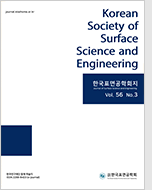
- Past Issues
- e-Submission
-

2021 Impact Factor 1.766
5-Year Impact Factor 1.674
Editorial Office
- +82-2-563-0935
- +82-2-558-2230
- submission@kssse.or.kr
- https://www.kssse.or.kr/

2021 Impact Factor 1.766
5-Year Impact Factor 1.674
The Korean Society of Surface Science and Engineering 2023;56(6):380-385. Published online: Dec, 28, 2023
DOI : 10.5695/JSSE.2023.56.6.380
In this study, an MPB PMNT system containing 0.05 to 0.10 wt.% BaTiO3 was synthesized using a traditional chemical method and its pyroelectricity was investigated. Pyroelectricity, dielectricity, and ferroelectricity of the synthesized BaTiO3-PMNT system were analyzed by heat treatment at 1240~1280 ℃ for 4 hours to evaluate its applicability as a pyroelectric sensor. Unlike the simple ABO3 ferroelectric, the BaTiO3-doped PMNT system exhibited phase transition characteristics over a wide temperature range typical of complex perovskite structures. Although no dramatic change could be confirmed depending on the amount of BaTiO3 added, stable pyroelectricity was maintained near room temperature and over a wide temperature range. When the amount of BaTiO3 added increased from 0.05BaTiO3-PMNT to 0.10BaTiO3-PMNT, the electric field slightly increased from 5.00x103 kV/m to 6.75x103 kV/m, and the maximum value of remanent polarization slightly increased from 0.223 C/m2 to 0.234 C/m2. The pyroelectric coefficients of 0.05BaTiO3-PMNT and 0.10BaTiO3- PMNT at room temperature were measured to be ~0.0084 C/m2K and ~0.0043 C/m2K, respectively. The relaxor ferroelectric properties of the BaTiO3-PMNT system were confirmed by analyzing the plot of Kmax/K versus (T-Tmax)γ. The BaTiO3-doped MPB PMNT system showed a distinct pyroelectric performance index at room temperature, and the values were Fv ~ 0.0362 m2/C, Fd ~ 0.575x10-4 Pa-1/2.
Keywords BaTiO3 ; PMNT ; Ferroelectric hysteresis ; Pyroelectricity.